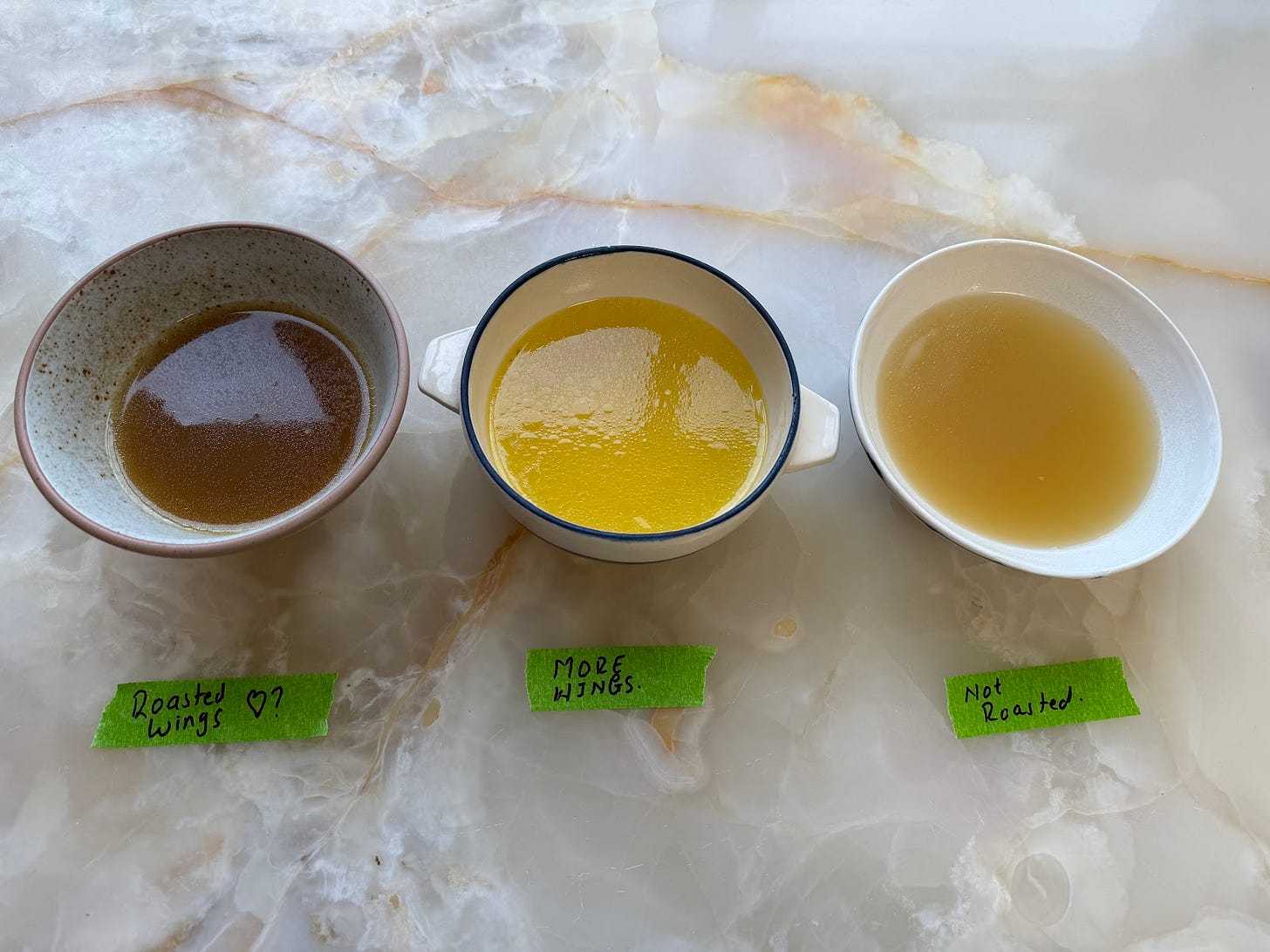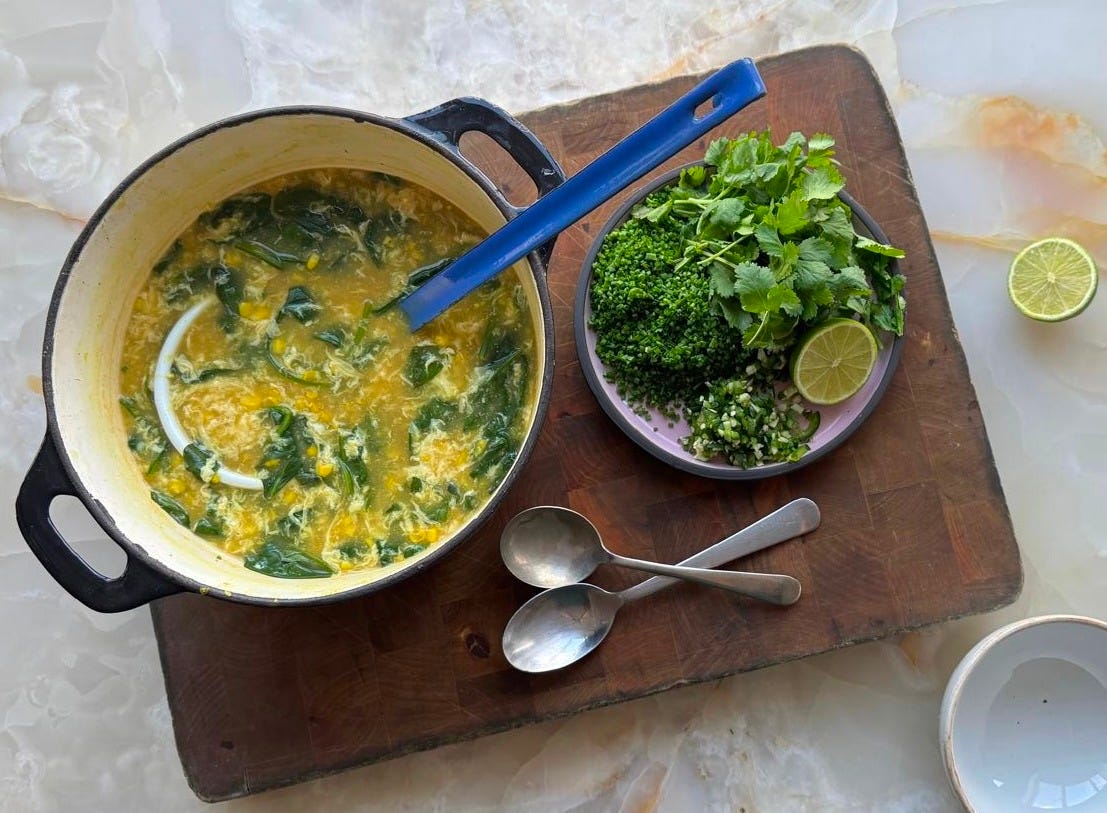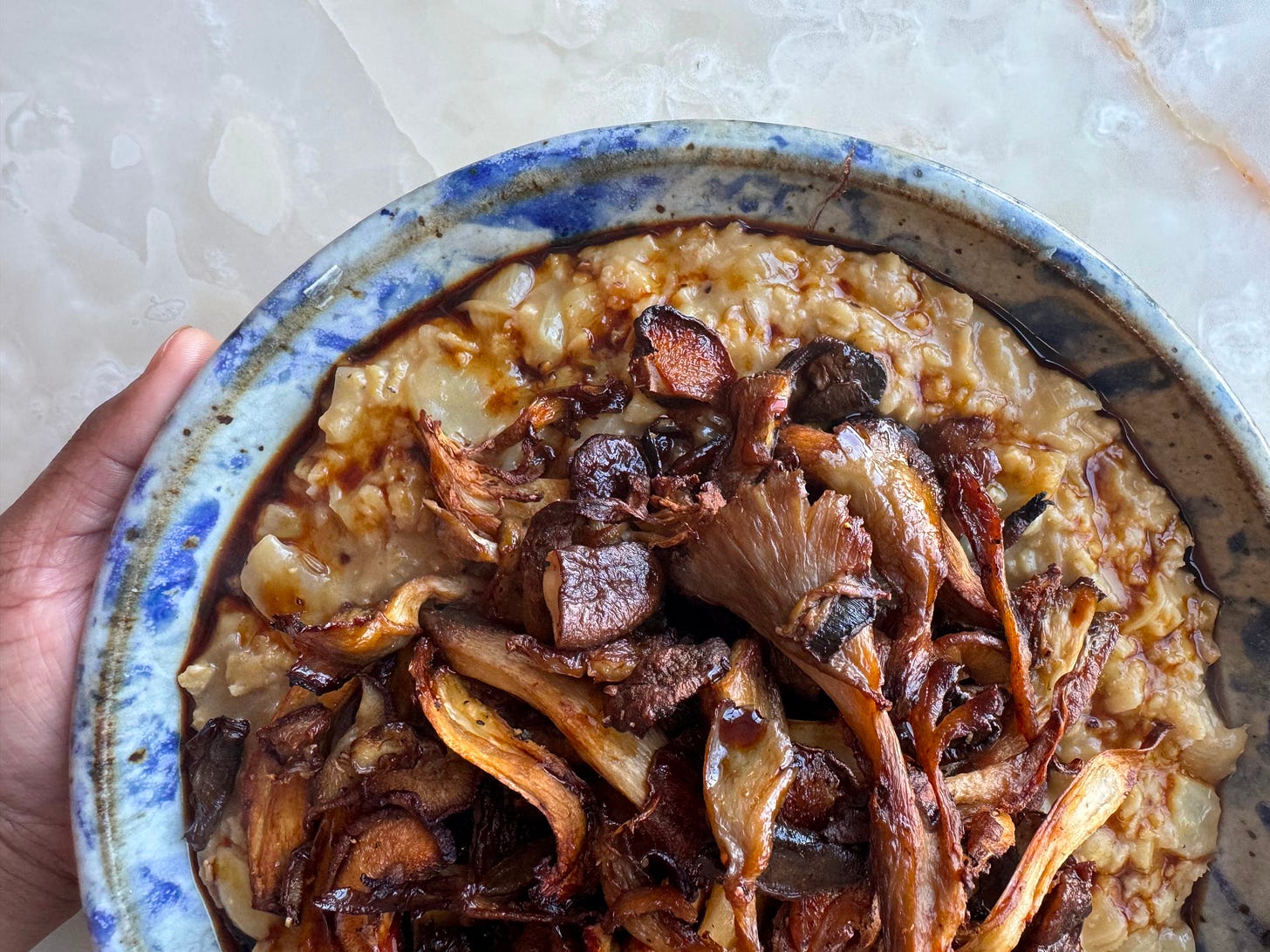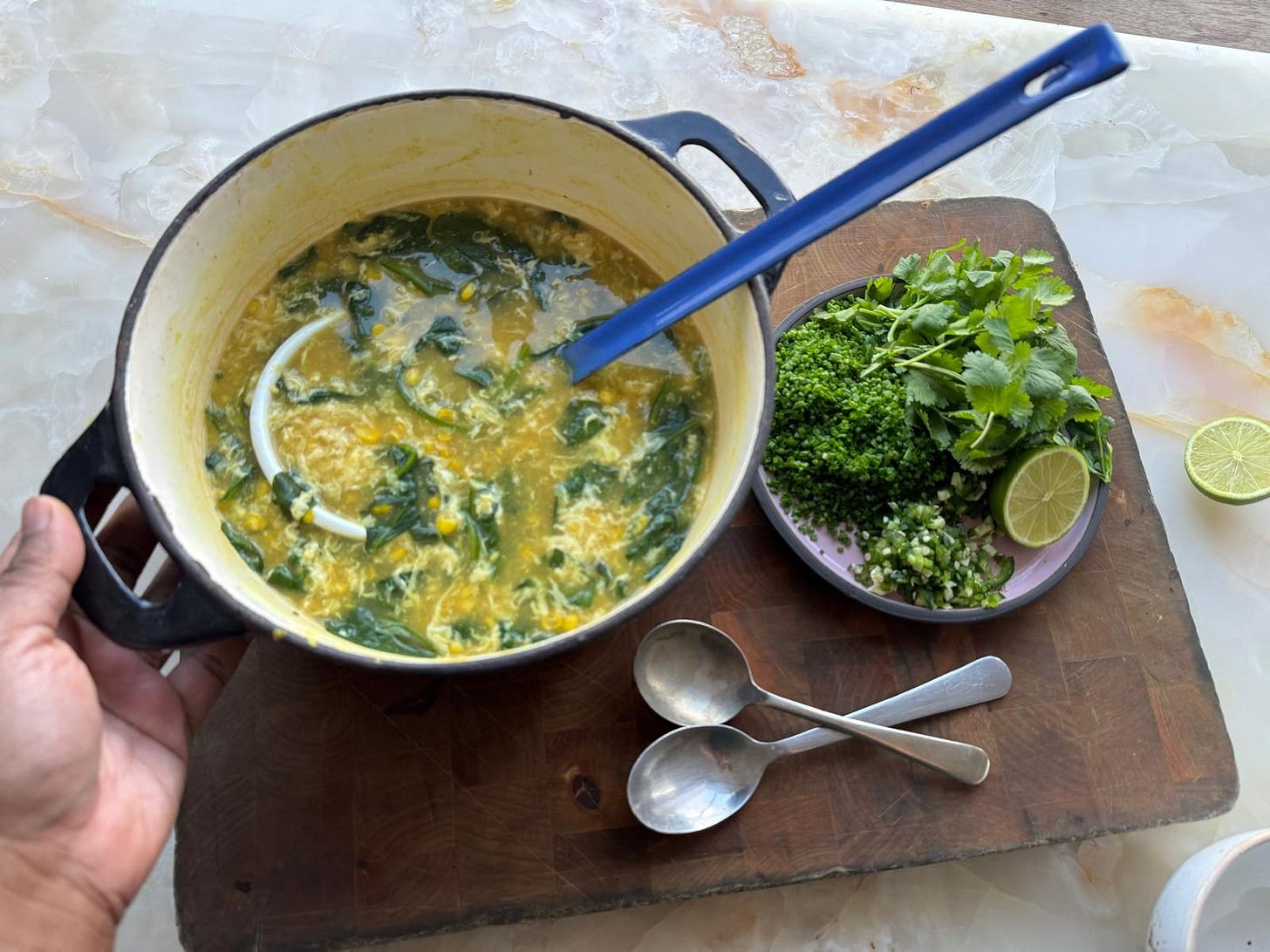How to Build a Broth
Chicken & sweetcorn egg drop soup, mushroom ‘risotto’ and building the perfect broth
There are many ways in which a restaurant kitchen is different from a domestic one, but the most striking one, for me, is THE STOCKPOT. I am using capitals just to show the scale of this ‘thing’. The stockpot bubbles away like a volcanic swamp, constantly needing to be fed. It’s astounding how this unglorious, epic thing–frothy and messy–is where the most delicate, profound flavours get started.
I never used to think that my home kitchen needed a bubbling stockpot. Or, more precisely, I thought the effort was too great for my needs. But recently, I’ve developed a habit of making broths more often, using up scraps and odd ends that have been collecting in my freezer.
I am not religious about it–not everything that’s edible ends up in a stockpot instead of the compost heap–but the aspiration is there. And for this, the freezer is my best friend. This is where a chicken carcass from Christmas, some forgotten carrots, ginger offcuts and the stubs of old Parmesan rinds get stashed, ready to be turned into broth.
Rachael Mamane, in her brilliant book Mastering Stocks and Broths, nails the art of using what’s usually tossed. The idea of making broth at home can feel like something from the past, but it’s actually gaining popularity. Stock cubes or sachets give you convenience–and I am all for that some of the time–but they do fall short on depth, soul and the satisfaction of making your own. Homemade broth is also far better for you, free from those unnecessary additives.
Over the past week, the test kitchen team have been revisiting broths to help make all the goodness more accessible; testing variations that fit into a more everyday (or perhaps Sunday) schedule.
And we’ve ended up with two recipes that will be on constant rotation in my kitchen this January: a mushroom risotto made with oats and a chicken and sweetcorn egg drop soup with all the ‘fixings’. As I said last week, I’m easing into the New Year slowly, craving meals that feel restorative. And there’s something about brothy soups that do exactly that.
Stock vs. broth
Stock and broth get discussed a lot, but they’re not quite the same. A stock is made by simmering bones (and sometimes veggies) for hours, leaving you with a rich, gelatinous liquid. Broth, though, tends to be lighter and more seasoned, perfect for sipping on its own. The lines blur in home kitchens, though—any broth can easily double as stock. The key is the foundation you’re building: a liquid that’s much more than just the sum of its parts.
How to build a broth
As Eric Sze says, “Cooking is like building a house. You need to lay a foundation, then add the bricks, the walls, the roof. Broth is very much the same thing.”
At its core, broth is simple—just water, ingredients, and time. But making a great broth isn’t just about tossing everything into a pot. It’s about layering, coaxing ingredients to unlock their best selves. Whether it’s the earthiness of a mushroom broth or the richness of chicken, it’s all about care. The right pot, the right base, and a little patience—those are the building blocks for something that tastes special.
1. Pick the right pot
A good broth starts with the right pot. A large, high-sided stockpot (about 6.5 litres) is ideal. But don’t worry, I know not everyone has one at home. Two smaller 3L pots will work just fine.
2. Choose your base
First question: meat, veg, or both? Whatever you choose, make sure to use a variety. For mushroom broth, mix up the mushrooms—shiitake, king oyster, whatever you’ve got.
Simple Porcini mushroom broth
Dried mushrooms bring a rich depth to quick broths. This one’s simple and comforting, and you can tweak it with whatever’s on hand—veg scraps, ginger slices, even dried seaweed if you fancy. The beauty of vegetable broths is that they don’t need much time.
Serves 4 | Prep Time 5 mins | Cook Time 30 mins
Ingredients
30g dried porcini mushrooms
1 onion, roughly chopped
1 carrot, roughly chopped
6 garlic cloves, peeled
150g fennel trimmings
¼ tsp black peppercorns
Fine sea salt
Place all ingredients in a saucepan with 2L cold water and 1½ tsp salt.
Bring to a boil, then reduce to medium and simmer for 30 minutes.
Strain, reserving the mushrooms if needed. Discard the rest of the solids.
Once you’ve made the mushroom broth, you’ve got the base for endless possibilities. Chaya turned this broth into a mushroom ‘risotto’ made with oats (finished with umami-rich crispy mushrooms and a drizzle of sweet Kecap Manis) for a slow weekend breakfast. But honestly, it’s perfect for any time of the day. Just remember, use rolled oats, not porridge oats—it makes all the difference.
Mushroom “risotto” with crispy mushrooms and Kecap Manis drizzle
3. Give it some love
Whether you’re using veggies or meat, the key is to cook them down first—roast or brown them to release their flavour. And don’t bother peeling your veggies—those skins add colour and extra flavour to the mix.
4. Start with cold water
Cold water helps bring out the impurities, which you can skim off to keep the broth clear. Skipping this step will leave you with a cloudy broth, and that’s not ideal.
5. Take your time
Good broth can’t be rushed. Vegetable broths come together in about 45 minutes, but meat broths need at least 3 hours of simmering to get that deep, rich flavour. You’re looking for the moment when the liquid no longer tastes like water but is full of depth and character.
6. Skim smart
Scum (those frothy bits on top) should be skimmed off as it appears. But fat? Let it stay while the broth simmers—it adds richness and depth. If you want a leaner broth, strain it at the end. Don’t toss the fat, though—use it for roasting any veg or potatoes.
To remove excess fat easily, let the broth cool in the fridge. The fat will rise to the top, ready to be skimmed off.
How to make a chicken broth
There’s a lot of debate about what part of the chicken to use—wings, feet, or a whole bird? We’ve tested it all, and each part brings something different to the table.

Roasted chicken wing broth
For a deep, caramelised flavour that’s perfect for gravies and hearty soups, roasting the wings is the key. The browned bits that develop during roasting add a rich depth to the broth.
Best for
Gravy for roasts
Sauces requiring a bold chicken flavour
Hearty soups like French onion or goulash
Makes 3 ½ to 4 litres | Prep Time 10 minutes | Cook Time 3 hours
Ingredients
1.5kg chicken wings
2 onions, peeled and quartered
1 garlic bulb, halved
2 leeks (230g), roughly cut into 3cm pieces
3-4 carrots (260g), roughly cut into 2cm pieces
1 tsp black peppercorns
1 tsp salt
Preheat the oven to 200°C.
Spread the chicken wings on a parchment-lined tray and roast for 30 minutes until golden brown.
Transfer the wings and any browned bits from the tray into a large stock pot. Add all remaining ingredients and cover with 5 litres of cold water.
Bring to a boil over medium-high heat. Reduce the heat to medium and simmer for 2 ½ hours, until the vegetables are soft and the wings fall apart.
Cool slightly, then strain through a fine mesh sieve, discarding the solids.
Use immediately or freeze in portions for up to a month.
Whole chicken broth
A go-to that serves up both rich broth and tender shredded chicken. Poaching a whole chicken lets the flavours from the meat and bones meld together, giving you a balanced broth while keeping the chicken moist and succulent.
Best for
Chicken noodle soup
Creamy risotto
Dishes requiring shredded chicken, like tacos or pies
Makes 3 ½ to 4 litres | Prep Time 10 minutes | Cook Time 2 hours 30 minutes
Ingredients
1 whole chicken (1.8kg)
2 onions, peeled and quartered
1 garlic bulb, halved
2 leeks (230g), roughly cut into 3cm pieces
3-4 carrots (260g), roughly cut into 2cm pieces
1 tsp black peppercorns
1 tsp salt
Combine all ingredients in a large pot and cover with 5 litres of water.
Bring to a boil over high heat. Reduce to medium and simmer for 1 hour 10 minutes.
Use tongs to remove the chicken and let it cool slightly. Shred the meat into chunks and return the bones to the pot.
Continue simmering for another 1 hour 20 minutes.
Strain through a fine sieve, discarding solids.
Use immediately or freeze for later.
Chicken feet broth
This rich, collagen-packed broth has a wonderfully gelatinous texture that adds a comforting body to so many dishes. As Mamane puts it, “If it jiggles, that’s good.” When chilled, the proteins turn into gelatine, giving it its signature wobble. It’s not strong in chicken flavour on its own, but paired with wings, it takes on a rich, savoury depth. You can usually find chicken feet at Asian supermarkets, your local butchers, or farmers' markets.
Best for
Ramen or pho
Sipping
Thickening sauces
Makes 3 ½ to 4 litres | Prep Time 10 minutes | Cook Time 2 hours 30 minutes
Ingredients
1kg chicken feet
2 onions, peeled and quartered
1 garlic bulb, halved
2 leeks (230g), roughly cut into 3cm pieces
3-4 carrots (260g), roughly cut into 2cm pieces
1 tsp black peppercorns
1 tsp salt
Combine all ingredients in a large pot and cover with 5 litres of water.
Bring to a boil over high heat. Reduce to medium and simmer for 2 ½ hours, until the chicken feet are falling apart.
Strain through a fine sieve, discarding solids.
Storage Tips
You should store broths in airtight containers in the fridge for up to 4 days or freeze for up to a month. For small portions, use ice cube trays—they’re perfect for loosening up pasta sauces or gravies.
Chicken and sweetcorn egg drop soup with “fixings”
Chicken broth is incredibly adaptable. Here are a few past applications that I love: with dumplings, pasta, and black-eyed beans.
For this one, Chaya was inspired by her favourite hot and sour soup from Good Fortune’s Club (her local takeaway), making some tweaks along the way. She added bursts of corn, the gentle heat of jalapeños, and a squeeze of lime.
The egg drop technique might sound tricky, but with a steady hand, it’s surprisingly easy. Stir the broth into a gentle whirlpool, then slowly pour in the beaten eggs, letting them drift into soft, delicate ribbons. Whether you like fine strands or thicker swirls is up to you—it’s all about finding the texture that feels right. Take your time, and let the broth do its quiet magic.
A quick tip on miso: before adding it to the pot, loosen it in a bit of the broth so it mixes properly into the soup. I’ll share more on how to get the best out of miso this Wednesday, so keep an eye out for that.
If things don’t go quite right—like if the eggs clump—don’t panic. Keep the broth at a gentle simmer, stirring steadily in one direction. Too thick? Just loosen it with a splash of broth.
I’d go for roasted chicken wing broth in this recipe—for its caramelised flavour and deep colour—but honestly, any of the options above will work. Even shop-bought stock will do the trick if time’s tight.
Serves 4-6 | Prep time 20 minutes | Cook time 20 minutes
1400ml chicken broth, set aside a ladleful (about 100ml) for later
250g frozen sweetcorn, half finely chopped






